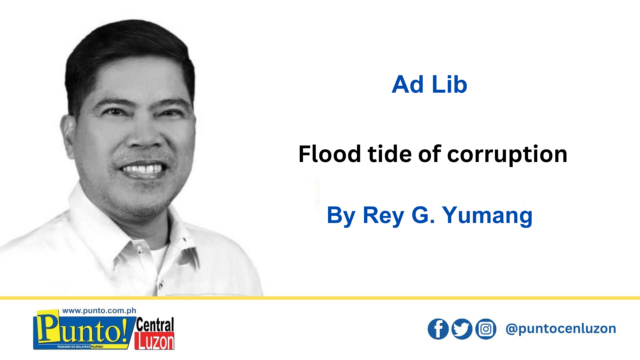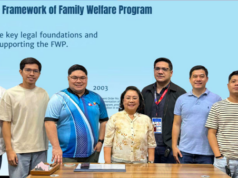QUITE A number of pundits have pointed to climate change as their convenient excuse to justify the failure of flood-control projects in the province. While global warming is a factor we cannot simply dismiss, I am sure many of you will agree that the recent flooding in Pampanga’s coastal towns is a mirror to the endemic corruption in many of our government’s flood-control initiatives.
No less than Sen. Panfilo Lacson dropped a bombshell that all of us have known all along – “of the nearly ₱2 trillion allocated to flood-control over the past 15 years, ₱1 trillion—half—may have been lost to corruption.”
President Bongbong Marcos, in his state of the nation address on July 28, bluntly condemned these flood-control projects as “substandard,” “collapsed,” and even “mere figments of imagination” and called out “kickbacks, initiatives, errata, SOP, ‘for the boys’” as the tools of corruption that have been sadly normalized by the Department of Public Works and Highways (DPWH) and many local government units (LGUs).
In his latest Facebook post, Pasig Mayor Vico Sotto has outlined the six stages of corruption inherent in government projects, from the first stage which is procurement/bidding to the last phase when the contractors themselves enter politics by fielding family members as candidates for an elective post, from the municipal level to as far as Congress either as a district or party list representative.
The LGUs occupy the front lines in the country. With political will, they can—and must—lead the charge to end corruption from bidding to completion.
First: transparent procurement. Can you imagine if every LGU would publicize and even live-stream bidding sessions, require open bidding for all contractors, and proactively reject companies with ties to officials or their kin? Just imagine how much money can be saved if no contractor participating in the procurement is related to any local official up to the fourth degree of sanguinity, or associated with and affiliated to any municipal government employee!
Second: community vigilance. With our collective voices, let us require public posting of project lists, maps, budgets, status reports, and photos. This would empower local communities to spot “ghost” or substandard projects quickly. In fact, President Marcos has instructed the DPWH to “submit all flood control projects completed or started in the past three years, with regional monitoring committees identifying failures, unfinished, and ghost projects.”
Third: independent audits that bite. The civil society groups and the Commission on Audit can join forces and they must be given both the access and the mandate to review projects from design to implementation. A local “watchdog” board, modelled on the regional project monitoring committee, would help detect under-delivering or failing works early.
Finally, LGUs must, once and for all, shun the SOPs that rationalize corner-cutting—where substandard designs are accepted because they’re “good enough.” Instead, adopt Filipino-centered engineering standards, consult with experts, and use climate-proof design.
After the flood waters inundated our town for almost three weeks, the stakes have never been this clear. Bigger budgets should lead to less flooding, right? How ironic that we have seen and experienced the exact opposite. As budget for flood control projects has increased over the years, so have the flood levels!
More than climate change, this is a problem of governance, as well. Local officials in our province can break the cycle. Transparency, community participation, real audits, and strong design standards can turn the tide.
Taking my cue from what President Marcos said in his SONA: “Dumine na kayu man ikayung makalukluk keng pwestu! Ala kayung pikabsiyan keng kapanakawan. E nakayu melunus man keng balen at kareng memalen!”
Of course, I could only look forward to that day when that shame shall truly inspire real, local action.





